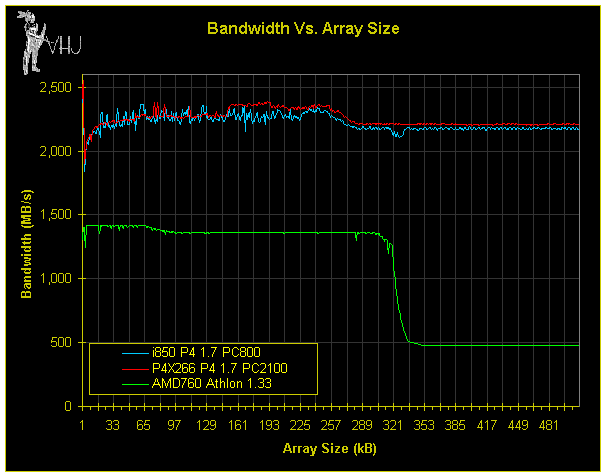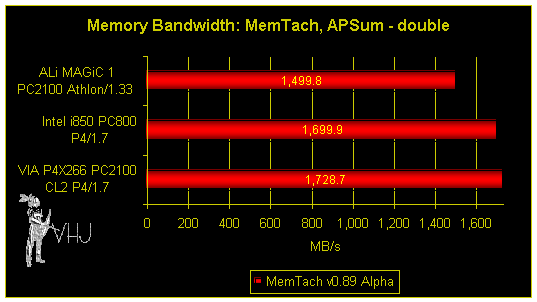
VIA's P4X266 Achieves Roughly 100% DDR SDRAM Bandwidth Efficiency
Posted By Van Smith
Date: August 14, 2001
A new core logic controller from VIA Technologies delivers very nearly the theoretical limits of DDR SDRAM. Using one of our own standard bandwidth measuring tools, we have witnessed VIA's new P4X266 deliver virtually 100% of the bandwidth promised by PC2100 DDR SDRAM. Additionally, the P4X266 reaches the same level of throughput as Intel's dual channel i850 Rambus RDRAM chipset on this test.
UPDATE: Please see update below where DDR SDRAM outperforms RDRAM on a popular memory bandwidth benchmark.
===================================
How to calculate bandwidth
Calculating maximum theoretical bandwidth for both memory technologies is fairly straight forward. SDRAM and DDR SDRAM are both systems that transfer data in parallel. To calculate the bandwidth for DDR SDRAM we must use the following formula:
bandwidthDDR SDRAM = d * f * w
= (2 transfers / tick) * (133 * 106 ticks / sec) * (8 bytes / transfer)
= 2,128 * 106 bytes / sec
The bandwidth for Rambus RDRAM is calculated differently because the memory is serialized:
bandwidthRDRAM = d * f * w * n
= ((2 transfers / tick) / channel) * (400 * 106 ticks / sec) * (2 bytes / transfer) * (2 channels)
= 3,200 * 106 bytes / s
Theoretically, a dual channel RDRAM system delivers considerably higher bandwidth than a single channel PC2100 system.
===================================
Results
The results below show that the VIA P4X266 not only delivers roughly maximum theoretical bandwidth, but, at least on this test, also reaches the same levels as the Intel i850 configured with dual channels of PC800 RDRAM. This suggests that DDR SDRAM is capable of much higher bandwidth efficiency than the Intel / Rambus combo which, in theory, should reach 3.2 GB / s (certainly the P4's L2 cache performance appears to be a limiter on this test).
Note: BandwidthBurn does not exploit software prefetching. The Athlon would fare much better if the program were software prefetch enabled, but we wanted BandwidthBurn to reflect typical existing applications. See the MemTach scores below for an example of a software prefetch enhanced test. The P4 does well on BandwidthBurn thanks to the chip's 128 byte L2 line size and hardware prefetching.

Please note that MB = 106 B as by STREAM conventions
Although the overall scores slightly favor the VIA P4X266, we believe that this is partially due to the fact that the VIA reference board was running at 1.72 GHz, which is slightly above rated clock speed. This slight overclocking is one reason why the bandwidth we obtained from PC2100 (about 2.2 * 106 B/s) is actually slightly higher than its maximum theoretical bandwidth. There also might be a very small granularity issue with the timing routine we used.
Also note how the P4 on either platform provides much greater raw bandwidth than the Athlon. Bandwidth is the Pentium 4's strong point. In most other performance areas, the Athlon gets the better of the Pentium 4. Alone, however, the P4's stellar bandwidth often partially (or even fully) compensates for its other shortcomings.
===================================
Rambus RDRAM is not magic
As we have been trying to inform the public for years, Rambus RDRAM is not magic. This technology faces the same technical barriers as SDRAM, but on top of this, data is serialized adding latencies and reducing practical throughput.
Rambus RDRAM is a technology best suited for environments where low pin count comes first, and performance second. Under such conditions the technology is good, but it will not fare well against opposition that avoids the penalties of data serialization like SDRAM and DDR SDRAM.
Expect to see more tests here of the exciting VIA P4X266 in the days to come.
===================================
UPDATE
Using Bill Henning's MemTach v0.89 Alpha, a comprehensive memory subsystem bandwidth evaluation tool, the VIA P4X266 with 256MB of P2100 rated at CL2 delivered higher throughput rates than the fastest 1.7 GHz P4 i850 PC800 system listed at Mr. Henning's CPUReview. The test we focused on is "APSum - double" a software prefetch enhanced floating point bandwidth evaluation designed to extract maximum performance from the memory subsystem.
The results below indicate that the VIA / DDR SDRAM platform is capable of delivering higher effective bandwidth than the Intel / Rambus combination. So far, the only test we have tried that has given the Intel / Rambus duo a bandwidth win is SiSoftware's Sandra, which ironically is the only direct bandwidth measurement tool used by most other reviewers. We will post more results in upcoming articles.

Get ready for more class action lawsuits: DDR
SDRAM outperforms RDRAM.
Notice how the Athlon fares much better in this test thanks to software prefetching.
===================================
Pssst! Our Donation Page is up.
===================================